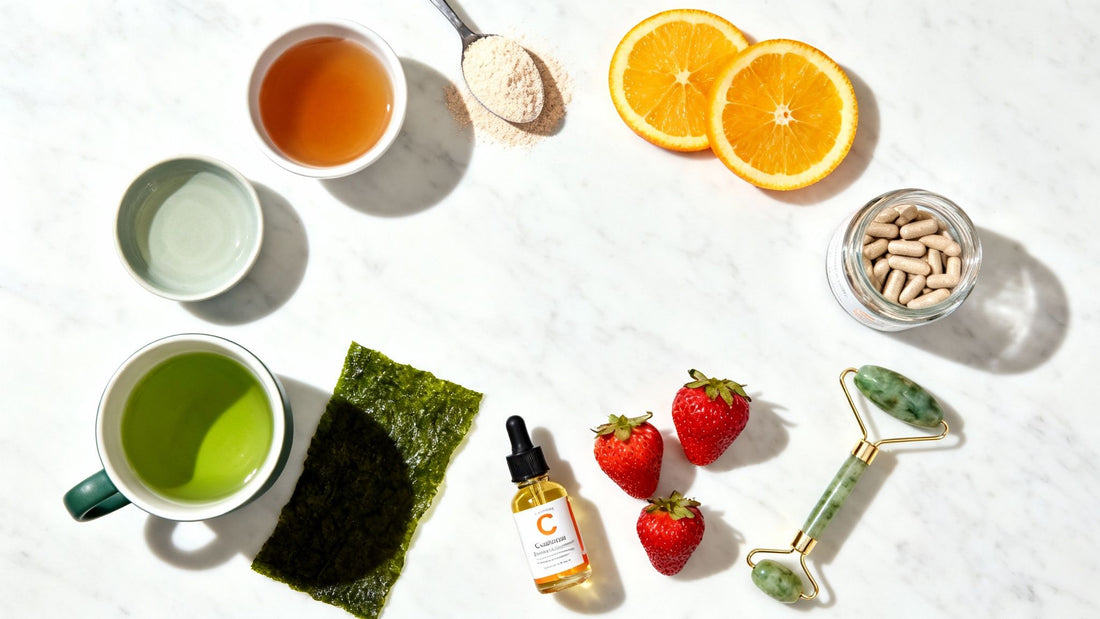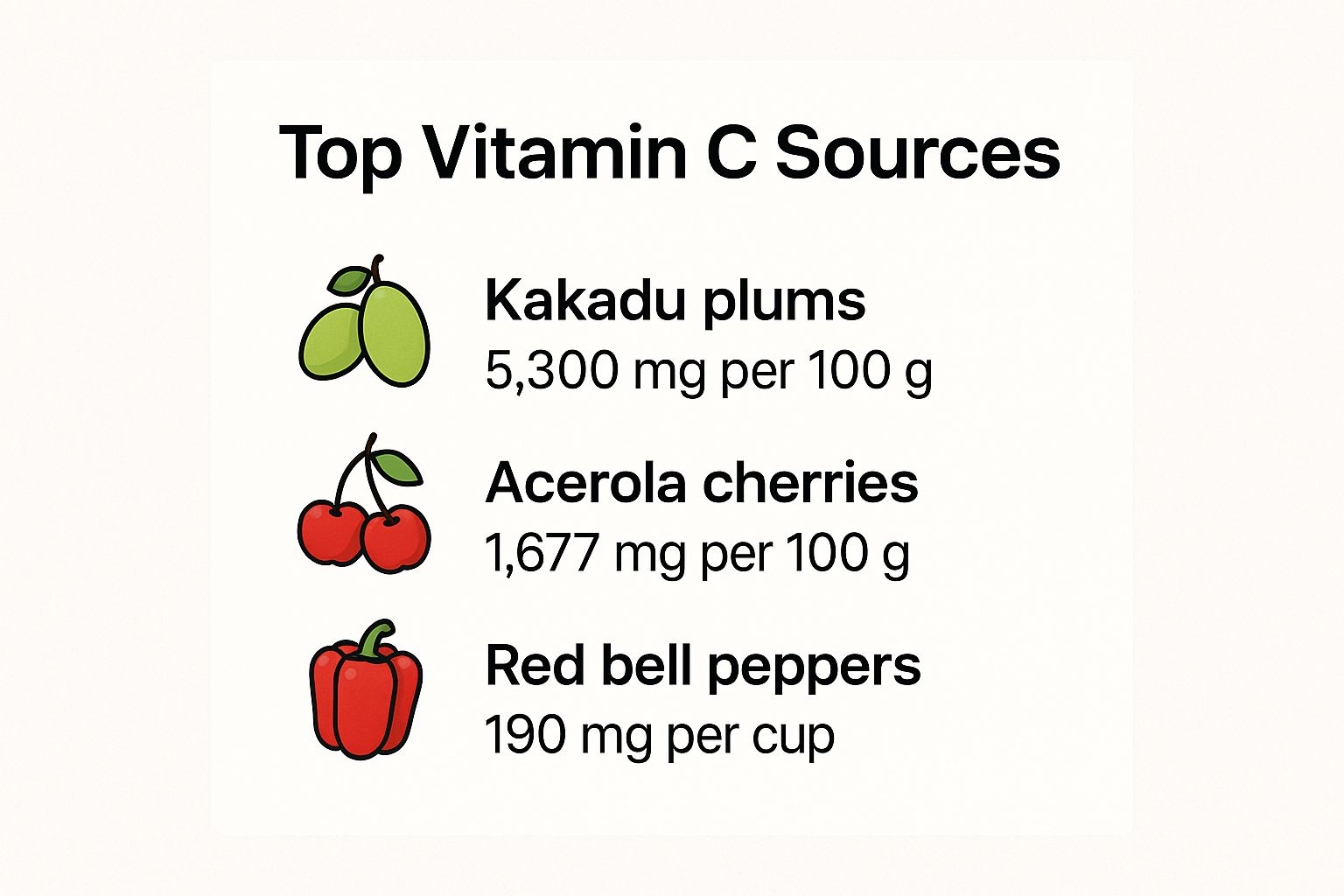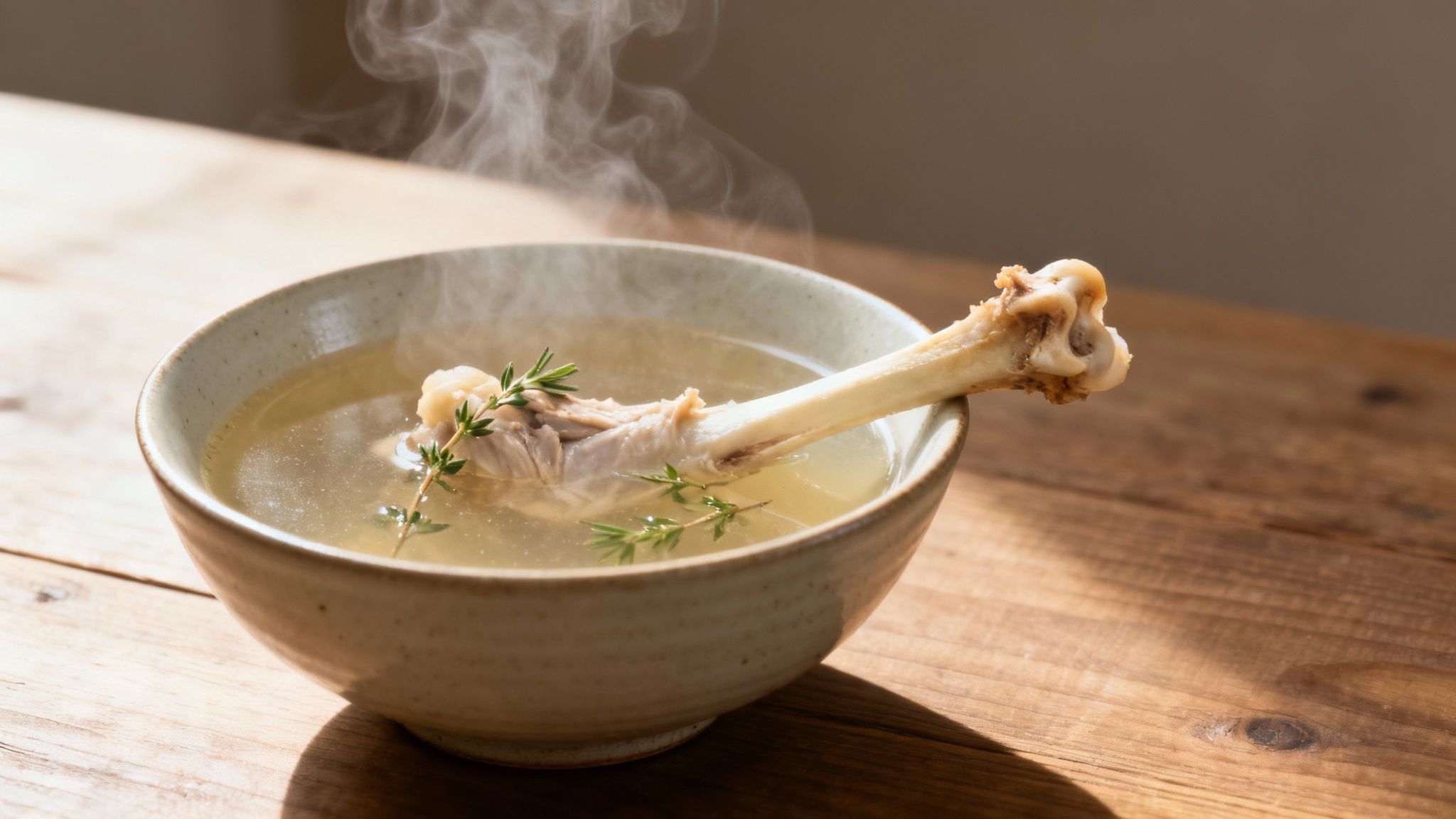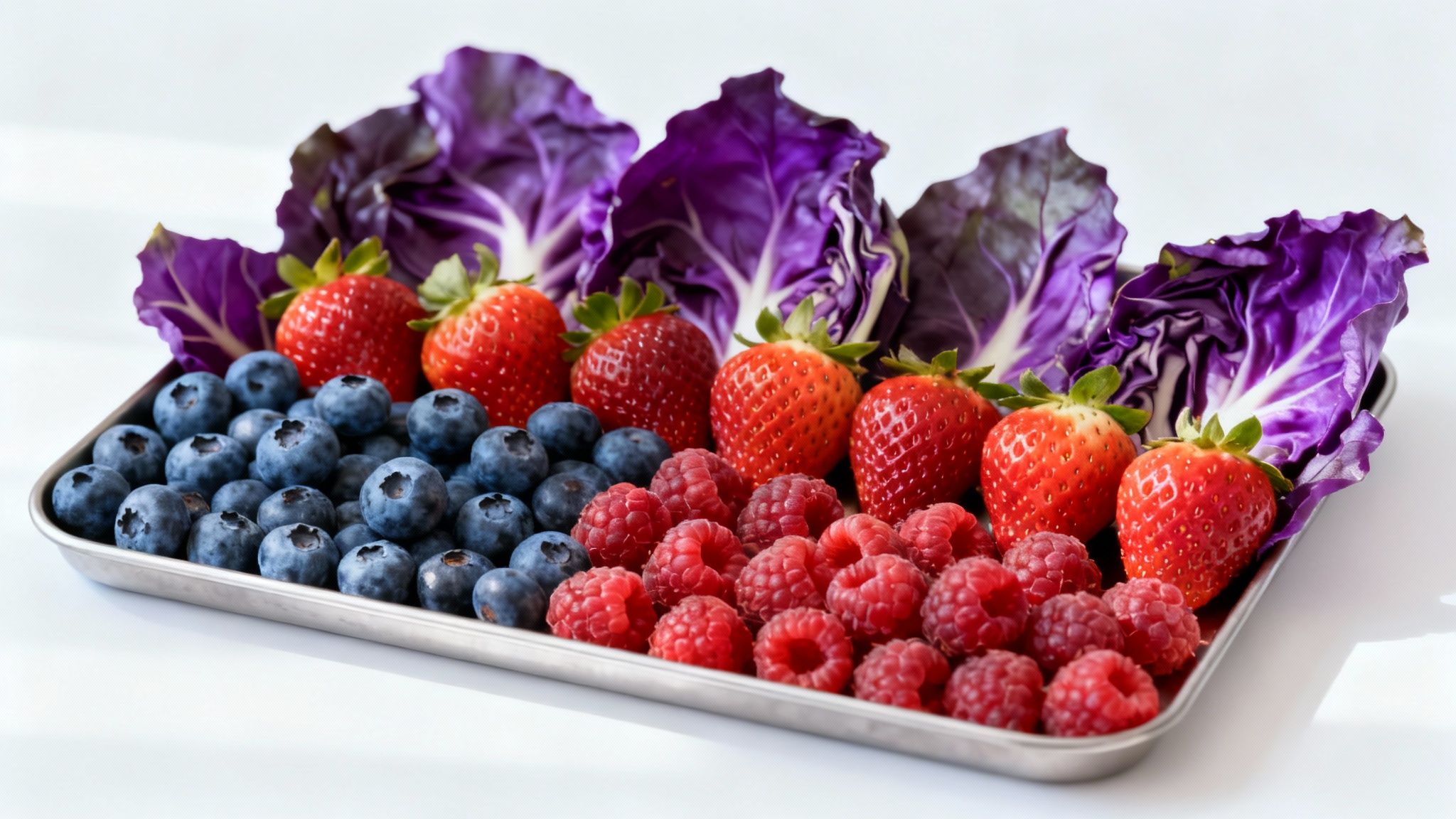
Collagen is the very framework of our skin, providing the strength, structure, and plumpness we associate with a youthful glow. As we age, its production naturally declines, leading to fine lines, wrinkles, and loss of elasticity. But what if you could naturally support and replenish this vital protein? This comprehensive guide moves beyond generic advice to reveal potent, science-backed natural ways to boost collagen from the inside out and reclaim your skin's vitality.
We'll explore specific foods, powerful nutrients, and innovative at-home technologies that work synergistically to rebuild your skin's foundation. While adding collagen-supportive habits is key, it's just as important to address factors that actively degrade it. For instance, understanding the benefits of stopping sugar is a crucial step, as excess sugar can weaken collagen fibers and accelerate skin aging.
This listicle will provide actionable strategies, from incorporating specific amino acids and antioxidants into your diet to leveraging targeted light therapy. One powerful tool is the Barb N.P. LED Facial Mask, a wireless, comfortable device with three distinct lighting settings designed to stimulate collagen production and enhance skin rejuvenation. This is your roadmap to cultivating lasting, vibrant skin health by empowering your body's innate ability to regenerate. Get ready to unlock the secrets to a firmer, smoother, and more radiant complexion.
1. Vitamin C-Rich Foods
Vitamin C is not just a general wellness booster; it's an indispensable component in the body's collagen production machinery. Think of it as the master key that unlocks collagen synthesis. This powerful antioxidant is a crucial cofactor for the enzymes proline hydroxylase and lysyl hydroxylase, which are responsible for stabilizing the collagen molecule and forming its strong triple-helix structure.
Without sufficient vitamin C, the body's ability to produce functional collagen grinds to a halt, leading to weakened connective tissues. This connection was famously observed in sailors suffering from scurvy, whose severe vitamin C deficiency caused collagen breakdown, resulting in bleeding gums and poor wound healing. Modern research validates this, showing that consistent intake of vitamin C is one of the most effective natural ways to boost collagen for firmer skin and healthier joints.
How to Implement Vitamin C in Your Diet
Integrating vitamin C into your daily routine is simple and delicious. The goal is to consume a variety of whole foods that are naturally rich in this nutrient to ensure a steady supply for your body's collagen-building processes.
- Eat the Rainbow: Aim to include foods like citrus fruits (oranges, grapefruit), berries (strawberries, kiwi), bell peppers, broccoli, and leafy greens in your daily meals.
- Preserve Nutrients: Consume these foods raw or lightly steamed. High-heat cooking can degrade vitamin C, reducing its effectiveness.
- Aim for Optimal Intake: While the recommended daily allowance (RDA) is 75-90mg, studies suggest that 200-500mg daily provides optimal support for collagen synthesis and skin health.
To help you identify the most potent sources, this chart highlights some of the top vitamin C-rich foods.

This quick reference shows that common sources like oranges are great, but less common foods like Kakadu plums and acerola cherries pack a much more powerful vitamin C punch. While dietary intake is foundational, combining it with a high-quality topical serum can significantly enhance results by delivering the antioxidant directly to the skin. You can explore the benefits of topical vitamin C serums to complement your dietary efforts and further protect your skin's collagen from environmental damage.
2. Bone Broth Consumption
Bone broth is a nutrient-rich liquid made by simmering animal bones and connective tissues for an extended time. This ancient practice, utilized for centuries in traditional medicine, extracts collagen, gelatin, and essential amino acids like glycine and proline. These compounds are the direct building blocks the body needs to synthesize its own collagen, making bone broth one of the most direct and effective natural ways to boost collagen.
The simmering process breaks down the collagen into a more easily digestible form called gelatin, which provides the raw materials for strengthening skin, hair, nails, and joints. This is why a well-made broth gels when refrigerated, a tell-tale sign of its high collagen content. Modern wellness advocates, from Dr. Josh Axe to chef Marco Canora, have repopularized this traditional food for its potent gut-healing and skin-rejuvenating benefits.

How to Implement Bone Broth in Your Routine
Incorporating bone broth is a simple and savory way to support your body’s collagen framework from the inside out. Consistency is key to seeing benefits, such as improved skin hydration and elasticity.
- Prioritize Quality: Use bones from grass-fed, pasture-raised, or wild-caught animals for the highest nutrient density. Include collagen-rich parts like chicken feet, knuckles, or oxtail.
- Slow Simmer for Success: Simmer chicken bones for at least 12 hours and beef bones for 24-48 hours. Add a splash of apple cider vinegar to help extract more minerals.
- Aim for Daily Intake: Consume one to two cups daily for optimal results. You can drink it warm with sea salt or use it as a base for soups, stews, and sauces.
While bone broth nourishes from within, combining it with advanced topical treatments can accelerate and enhance your results. The Barb N.P. LED Facial Mask is a perfect complement to this internal approach. This comfortable, wireless mask features three lighting settings, including a red light therapy mode clinically shown to stimulate fibroblast cells, which are responsible for producing collagen and elastin. This creates a powerful inside-out strategy, where the broth provides the building materials and the light therapy energizes the production factories, leading to visibly firmer and more youthful-looking skin.
3. Dietary Sulfur from Cruciferous Vegetables and Alliums
Often overlooked in conversations about skin health, dietary sulfur is a foundational mineral that acts as a structural anchor for collagen. It is essential for forming the strong disulfide bonds that give the collagen helix its resilience and stability. Think of sulfur as the mortar holding the collagen bricks together; without it, the entire structure weakens.
This vital mineral is also a key component of compounds like methylsulfonylmethane (MSM), which clinical studies show can significantly improve skin texture and reduce wrinkles. Consuming sulfur-rich foods, particularly cruciferous vegetables and plants from the allium family, provides your body with the necessary building blocks to both produce new collagen and protect existing stores from degradation. This makes sulfur one of the most effective and unsung heroes in the quest for natural ways to boost collagen.

How to Implement Dietary Sulfur in Your Diet
Incorporating sulfur into your meals is a straightforward strategy to support your body’s collagen framework. The goal is to consistently include a variety of sulfur-containing foods to ensure your tissues have the resources they need for strength and repair.
- Embrace Alliums: Regularly add garlic, onions, leeks, and shallots to your cooking. For maximum benefit, crush or chop garlic and let it sit for 10 minutes before heating to activate its beneficial sulfur compounds.
- Consume Cruciferous Vegetables: Make broccoli, cauliflower, Brussels sprouts, kale, and cabbage staples in your diet. Lightly steaming these vegetables helps preserve their delicate sulfur compounds, which can be lost with high-heat boiling.
- Aim for Consistency: Strive to include two to three servings of sulfur-rich foods daily to provide a steady supply for ongoing collagen synthesis. Combining them with vitamin C-rich foods creates a powerful synergistic effect.
While a nutrient-rich diet is fundamental, you can further enhance your results by incorporating advanced at-home treatments. The Barb N.P. LED Facial Mask complements your internal efforts by using specific wavelengths of light to stimulate cellular activity. Its comfortable, wireless design features three settings—including a red light option known to penetrate the skin and directly energize the cells responsible for collagen production, creating a comprehensive inside-out approach to skin rejuvenation.
4. Hyaluronic Acid from Plant Foods
Hyaluronic acid (HA) acts as the body's internal moisturizer, a powerful humectant that can hold up to 1,000 times its weight in water. While it doesn't build collagen directly, it creates the ideal hydrated environment for collagen fibers to thrive. When skin is well-hydrated, collagen and elastin have the support they need to maintain their structure, resulting in a plump, resilient, and youthful appearance.
By promoting optimal hydration, HA indirectly supports collagen integrity, preventing it from becoming brittle and prone to degradation. This synergy is one of the most effective natural ways to boost collagen's performance and longevity. Research highlights this connection, with studies on Japanese populations showing that diets rich in phytoestrogens from foods like soy correlate with higher HA levels and better skin quality into old age. This underscores the power of dietary choices in maintaining a supple, collagen-rich complexion.
How to Implement HA-Boosting Foods in Your Diet
Boosting your body’s hyaluronic acid production through diet involves focusing on foods rich in the necessary precursors and protective compounds. The strategy is to consume nutrients that either stimulate HA synthesis or inhibit its breakdown.
- Eat Your Roots (and Soy): Incorporate starchy root vegetables like sweet potatoes and carrots, which are rich in HA precursors. Soy products like tofu and edamame contain isoflavones known to increase HA production.
- Focus on Key Minerals: Magnesium and zinc are crucial for HA synthesis. Add magnesium-rich foods like leafy greens, nuts, and seeds, as well as zinc sources like pumpkin seeds and cashews.
- Protect Existing HA: Consume citrus fruits and tomatoes, which are high in a compound called naringenin that helps inhibit the enzyme responsible for breaking down hyaluronic acid.
- Hydrate Consistently: Drink plenty of water throughout the day. Hyaluronic acid needs water to work its magic, so proper hydration is non-negotiable for it to effectively plump the skin.
While dietary HA support is foundational, many people explore injectable treatments that use hyaluronic acid to restore volume and structure directly. These dermal fillers are a popular option for immediate results. You can learn more about how hyaluronic acid is used in dermal fillers to understand how this powerful molecule works both inside and out.
5. Copper-Rich Foods
Copper is a vital trace mineral that acts as a critical operator in the body's collagen-building factory. Its primary role is to activate the enzyme lysyl oxidase, which is essential for cross-linking collagen and elastin fibers. This process weaves individual fibers together, creating the strong, resilient matrix that gives structure to your skin, bones, and blood vessels. Think of it as the final step that locks everything into place for maximum strength.
Without adequate copper, this crucial cross-linking process falters, resulting in weak and fragile connective tissues. The importance of copper is starkly illustrated by Menkes disease, a genetic disorder of copper deficiency that leads to severely abnormal collagen. Research further supports this, showing that insufficient dietary copper can weaken blood vessels and that copper peptides can significantly enhance wound healing and collagen remodeling, making it one of the most important natural ways to boost collagen.
How to Implement Copper in Your Diet
Incorporating copper-rich foods is a straightforward way to support your body's collagen framework. The key is to consume a variety of sources to maintain a healthy balance, as excessive copper can be counterproductive.
- Prioritize Nutrient-Dense Sources: Organ meats like liver are exceptionally high in copper. For those who prefer other options, shellfish such as oysters and crab are excellent choices.
- Incorporate Plant-Based Powerhouses: Nuts and seeds, particularly cashews and sunflower seeds, are fantastic sources. Dark chocolate (70% cacao or higher), legumes like chickpeas and lentils, and shiitake mushrooms are also rich in this mineral.
- Aim for a Balanced Intake: The recommended daily allowance is about 900 mcg, but for targeted collagen support, aiming for 1-2 mg can be beneficial. It's important to balance copper with zinc, ideally maintaining a ratio of around 10:1 zinc to copper.
To take your collagen-boosting routine to the next level, pairing a nutrient-rich diet with advanced skincare technology can deliver remarkable results. The Barb N.P. LED Facial Mask complements your internal efforts by stimulating cellular activity from the outside. Its comfortable, wireless design features three light settings, including red light therapy known for promoting collagen synthesis. This dual approach of nourishing from within and stimulating from without creates an optimal environment for youthful, resilient skin.
6. Protein-Rich Foods with Collagen-Building Amino Acids
Collagen itself is a protein, so it stands to reason that providing your body with the necessary protein building blocks is fundamental to its production. Collagen's unique structure is composed primarily of three amino acids: glycine, proline, and hydroxyproline. Consuming high-quality, protein-rich foods supplies your body with these critical components, creating the raw material needed for robust collagen synthesis.
Without an adequate supply of these amino acids, your body cannot efficiently build or repair collagen, leading to a decline in skin elasticity, joint health, and overall tissue integrity. Experts like Dr. Gabrielle Lyon, an advocate for muscle-centric medicine, emphasize that sufficient protein intake is non-negotiable for maintaining healthy connective tissues and promoting graceful aging. This makes a protein-focused diet one of the most foundational natural ways to boost collagen.
How to Implement Protein in Your Diet
Strategically incorporating high-quality protein into your meals ensures a consistent supply of amino acids for your body's collagen-producing pathways. The goal is to focus on both quantity and quality to maximize the benefits for your skin and joints.
- Hit Your Target: Aim for a daily protein intake of 0.8-1.2 grams per kilogram of body weight. This is particularly important for active individuals and aging adults who have higher protein needs.
- Spread It Out: Distribute your protein intake evenly throughout the day, aiming for 20-30 grams per meal. This approach optimizes muscle and collagen protein synthesis far more effectively than consuming the majority of your protein in one sitting.
- Choose Complete Proteins: Prioritize complete protein sources that contain all essential amino acids. Excellent choices include grass-fed meat, wild-caught fish, pasture-raised eggs, and dairy products.
- Combine Plant Sources: For those following a plant-based diet, it's crucial to combine different protein sources, such as beans with rice or lentils with quinoa, to create a complete amino acid profile.
- Enhance with Vitamin C: Always pair your protein-rich meals with vitamin C sources like bell peppers or broccoli. Vitamin C is essential for converting proline into hydroxyproline, a critical step in forming stable collagen.
7. Antioxidant-Rich Berries and Colorful Produce
While not direct building blocks of collagen, antioxidants act as its essential bodyguards. They play a critical protective role by neutralizing free radicals, which are unstable molecules that damage and break down existing collagen fibers. This process, known as oxidative stress, is accelerated by UV radiation, pollution, and even normal metabolism, leading to a visible loss of skin firmness and elasticity.
Consuming a diet rich in antioxidants, particularly polyphenols like anthocyanins and carotenoids, provides a powerful defense against this collagen degradation. This is one of the most effective natural ways to boost collagen preservation and support the cellular environment needed for new synthesis. Research validates this link, with studies showing that populations consuming high amounts of colorful produce, like those following a Mediterranean diet, exhibit better skin aging markers and higher collagen density.
How to Implement Antioxidants in Your Diet
Integrating a wide array of antioxidants is key to protecting your collagen from all angles. The strategy is to "eat the rainbow," ensuring your body receives a diverse spectrum of these protective compounds daily.
- Prioritize Berries and Pigmented Produce: Make blueberries, strawberries, tomatoes, beets, and purple cabbage staples in your diet. Studies show that compounds like blueberry anthocyanins can reduce UV-induced collagen breakdown, while lycopene from tomatoes protects skin collagen from sun damage.
- Brew Green Tea: Aim for 3-4 cups of green tea daily. Its potent polyphenols, especially EGCG, have been shown in dermatological studies to shield collagen from UV damage and enhance its production.
- Embrace Herbs and Spices: Liberally use turmeric, cinnamon, and oregano in your cooking. These are concentrated sources of powerful anti-inflammatory and antioxidant compounds.
- Enhance Absorption: Pair these foods with healthy fats like olive oil or avocado to improve the absorption of fat-soluble antioxidants like carotenoids.
To further enhance this defensive strategy, innovative treatments can complement your dietary efforts. For example, treatments that reduce cellular stress can amplify the benefits of an antioxidant-rich diet. You can explore the benefits of LED light therapy, which works at a cellular level to support skin health and rejuvenation, creating a powerful synergy with your nutritional intake.
8. Omega-3 Fatty Acids from Marine and Plant Sources
Omega-3 fatty acids are not just vital for heart and brain health; they are unsung heroes in maintaining a robust collagen network. These essential fats, particularly EPA and DHA found in marine sources, protect and support collagen through their powerful anti-inflammatory properties. Chronic inflammation is a key culprit in collagen degradation, and by mitigating this process, omega-3s help preserve the skin's structural integrity, elasticity, and hydration.
Omega-3s work by creating a healthier cellular environment for fibroblasts, the cells responsible for producing collagen. They also strengthen the skin's lipid barrier, which works in tandem with collagen to keep the skin supple and resilient. Research confirms this connection, with studies showing that regular omega-3 intake can reduce UV-induced collagen breakdown and improve signs of photoaging. Including omega-3s is one of the most effective natural ways to boost collagen by defending it from inflammatory damage.
How to Implement Omega-3s in Your Diet
Integrating omega-3 fatty acids into your routine involves focusing on high-quality sources and ensuring proper absorption to maximize their collagen-protecting benefits.
- Prioritize Fatty Fish: Aim to consume fatty fish like wild-caught salmon, mackerel, sardines, or herring two to three times per week.
- Embrace Plant Sources: If you follow a plant-based diet, incorporate flaxseeds, chia seeds, walnuts, and hemp seeds into your meals. Consider an algae-based supplement for a direct source of EPA and DHA.
- Supplement Smartly: If dietary intake is insufficient, a high-quality fish oil or algae oil supplement can provide a consistent dose. Look for third-party tested products to ensure purity and potency.
To further enhance your collagen-boosting regimen, integrating professional-grade topical treatments can provide targeted support. A powerful option is the SkinCeuticals C E Ferulic serum, which combines potent antioxidants like vitamin C and E to protect existing collagen from environmental damage. This advanced formula complements the internal anti-inflammatory benefits of omega-3s, creating a comprehensive defense system for your skin. By pairing a nutrient-rich diet with clinically proven topicals, you provide your skin with the ultimate support for lasting firmness and health.
Natural Collagen Boosters Comparison
| Item | Implementation Complexity 🔄 | Resource Requirements ⚡ | Expected Outcomes 📊 | Ideal Use Cases 💡 | Key Advantages ⭐ |
|---|---|---|---|---|---|
| Vitamin C-Rich Foods | Low - simple dietary inclusion | Low - widely available, affordable | Improved collagen synthesis, antioxidant protection, skin elasticity | Daily collagen support, antioxidant defense | Synergistic with nutrients, multiple health benefits, safe |
| Bone Broth Consumption | High - long simmering time | Moderate - quality bones needed | Provides bioavailable collagen precursors and minerals, gut and joint support | Traditional diets, gut healing, collagen precursor intake | Rich in collagen amino acids and minerals, versatile |
| Dietary Sulfur from Cruciferous & Alliums | Moderate - daily vegetable prep | Low - common vegetables | Strengthened collagen cross-linking, antioxidant glutathione support | Long-term collagen structure support, skin/hair/nails health | Abundant, safe, supports multiple connective tissue elements |
| Hyaluronic Acid from Plant Foods | Moderate - dietary planning | Low - mostly plant-based foods | Enhanced skin hydration, indirectly supports collagen function | Skin hydration and anti-aging support | Plant-based, supports hydration, well-tolerated |
| Copper-Rich Foods | Moderate - specific food choices | Low to moderate - varied sources | Improved collagen cross-linking, skin elasticity, antioxidant protection | Connective tissue health, wound healing, pigmentation | Potent cofactor, multiple tissue benefits, small dose needed |
| Protein-Rich Foods with Collagen Amino Acids | Moderate - balanced intake needed | Moderate to high - quality protein sources | Provides essential amino acids for collagen synthesis, muscle maintenance | Foundational collagen production, diverse diets | Essential building blocks, adaptable to diet types |
| Antioxidant-Rich Berries & Produce | Low - simple variety inclusion | Low - widely available | Protection of collagen from oxidative damage, reduced inflammation | Preventative skin aging, UV protection | Diverse, safe, multiple protective mechanisms |
| Omega-3 Fatty Acids from Marine & Plant Sources | Moderate - sourcing quality key | Moderate - fish/plant sources | Anti-inflammatory effects, collagen protection, improved skin barrier | Inflammation-related collagen support, skin health | Multi-system benefits, well-researched, supports skin & joints |
Your Pro-Collagen Toolkit: Integrating Diet and Advanced Technology
Building and protecting your body’s collagen framework is a multifaceted journey, not a single destination. As we've explored, the most effective natural ways to boost collagen begin on your plate. Consistently integrating key nutrients is the non-negotiable foundation for maintaining firm, resilient skin and healthy connective tissues. This means prioritizing vitamin C from vibrant produce, sourcing essential amino acids from high-quality proteins, and ensuring a steady supply of minerals like copper and sulfur from diverse whole foods.
Think of your diet as the raw material for your body's collagen factory. Berries, leafy greens, lean meats, and alliums don’t just offer general health benefits; they provide the specific building blocks your fibroblasts need to synthesize new collagen fibers. Embracing this nutritional strategy empowers you to support your skin's structural integrity from the inside out, leading to more sustainable and authentic results than any single cream or treatment could ever offer. While a nutrient-dense diet is paramount, some individuals find that adding a targeted supplement, like Marine Collagen supplements, can provide extra support for their pro-collagen goals.
However, to truly accelerate and amplify these internal efforts, you can strategically pair your nutritional discipline with advanced, non-invasive technology. This is where at-home devices bridge the gap between daily skincare and professional treatments, creating a powerful synergistic effect.
Amplify Your Results with Targeted Technology
For those serious about maximizing their skin’s potential, incorporating a device like the Barb N.P. LED Facial Mask can be a game-changer. This tool moves beyond surface-level care, using clinically proven light therapy to stimulate cellular activity deep within the dermis.
- Red Light for Collagen Synthesis: The red light setting is specifically designed to energize the fibroblasts, the very cells responsible for creating collagen and elastin. Consistent use can encourage more robust and efficient collagen production, helping to diminish fine lines and improve skin elasticity.
- Comprehensive At-Home Treatment: The Barb N.P. mask stands out with its comfortable, wireless design that makes regular use effortless. With three distinct lighting modes (red for collagen, blue for acne, and amber for rejuvenation), it delivers a versatile, clinic-level experience tailored to your skin’s needs.
By combining a nutrient-rich diet with the targeted stimulation of LED therapy, you create a comprehensive support system for your skin. Your body has the internal resources it needs, and the external technology provides the catalyst to put those resources to optimal use. This integrated approach is the modern secret to achieving and maintaining vibrant, youthful skin for years to come.
Ready to explore personalized solutions that complement your natural collagen-boosting efforts? At BotoxBarb, we specialize in advanced aesthetic treatments that enhance your skin's health and appearance. Discover how our expertly administered services can help you achieve your skincare goals by visiting our shop at BotoxBarb today.

